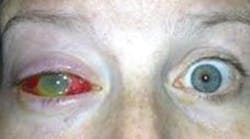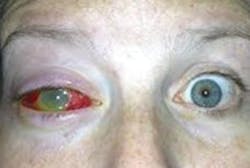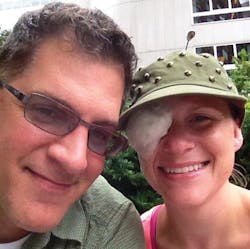Eye injury prompts dental patient to advocate safety glasses
BY Noel Kelsch, RDHAP
When you choose to practice infection control at the highest standards, when you incorporate best practices beyond what is required by law, you never know who you could be impacting. You never know the outcome that you may have avoided.
For Jenn, it started as just another day. She was squeezing in a root canal between work and going home to take care of the kids. As she sat in the chair, thinking about grocery lists and errands to run, she watched the clinicians do their job through the noise of the drill.
Jenn shared her story. When the dentist numbed her, he erred in more than one way. He passed the syringe over her face, rather than her chest, without recapping the needle first. Worst of all, he and his team did not give Jenn a pair of safety glasses that had been approved by the American National Standards Institute (ANSI).
The story does not stop there. An accident was waiting to happen because best practices were not in place, and it did.
"He dropped [the needle] directly in my eye," reports Jenn. "The needle with the streptococcus bacteria punctured my eye, injecting the bacteria into it. I was not wearing eye protection."
Jenn wasn't wearing eye protection because no one offered it to her, and she was not aware that she needed it. To make matters worse, the dentist did not follow the protocol for an eye injury in the dental setting. Instead of leading Jenn to the eye wash station, he offered her a wet tissue. Then, he completed the root canal without addressing her injury.
The next day, after Jenn had gone home and the numbness had worn off, she woke up with "extreme pain and felt like [her] brain was being eaten." She went to the emergency room, where the doctors washed her eye, applied an antibiotic, and injected steroids directly into her eye. Her eye continued to get worse, and she was admitted to the hospital for a three-day course of in-patient antibiotics and washouts.
Over the next week, Jenn had multiple surgeries for biopsy, infection removal, and finally, the removal of her lens. The infection, caused by the dentist's negligence, had led her retina to become completely detached. The doctors knew they had to take the chance since Jenn's vision was unlikely to return.
"I feel like half of my world was taken away," said Jenn. "I have post-traumatic stress disorder, and I suffer from panic attacks and flashbacks every day. This event has put a real financial burden on my family. My husband always tells me how beautiful I am. With only one eye, it's hard to feel that way (my eye was not removed but has shrunk to about half the size of my other eye). My daughters were always used to a fun, energetic, playful mother who always had a smile on her face and confidence on her back ... it's hard to get in their little heads (ages five and seven), but I know they are very sad and confused. I try my best to make them understand. Everyone I love and know feels the impact of my injury; this didn't just happen to me ... they all lost a little of me, too. I wear sunglasses almost 24/7 - even inside."
In addition to the stress that the accident caused in her personal life, Jenn also had to leave her job because she could no longer do her work. Since then, she has made it her mission to help others become more aware of the need for protective eyewear in the dental setting.
"Knowing the dangers of not wearing eye protection is a must," said Jenn, who reaches out to others about protecting themselves during dental visits. "Most people I talk to have never given it much thought; I never did before [the accident] either, unfortunately. Dentists should be handing out approved eye protection to every patient for every procedure. If they do not provide [eyewear] or have [eyewear], you must wear something - even your sunglasses are better then nothing!"
| Empower Your Patients: |
One of the greatest things we can do in infection control and prevention is empower our patients to be their own advocates. Treating them as though they are part of the dental team will keep them safe at referral appointments, and it's a great way to help the team remember protocols. Focus on the following: 1. Educate your patients on why you are giving them eye protection. Empower them to be able to ask for it if anyone ever forgets to offer it.2. Educate your patients about why it is vital in fourhanded dentistry never to pass items over a patient's face. Have them remind anyone who is not following this protocol how important it is. 3. Educate your patients on recapping needles, and empower them to remind staff if the protocol is not followed. |
As part of her mission, Jenn is also reaching out to dentists and hygienists. "Please!" she asks. "Don't ever let this happen to anyone again. Make sure all your patients wear ANSI-approved eye protection for any procedure."
Jenn's positive outlook is admirable. In her efforts to raise awareness, she has developed a Facebook hashtag movement (#JennsVisionSunglassSelfie), a Facebook page (www.Facebook.com/JennsVision), and a YouTube video (www.youtube.com/watch?v=7r0jVgHx2do).
Taking care of patients: A call to action
This is a call to action that I hope you will share with your fellow colleagues, as well as all of your patients. Just like clinicians, all patients must wear eye protection in the dental setting to ensure safety.1
When patients sit in the chair, they can be exposed to so many things that could injure the head, neck, and eyes. Even a handpiece could cause irreversible damage. With a rotation speed of 180,000 to 500,000 times per minute, handpieces could project particles at speeds up to 50 miles per hour. Chemicals, pieces of old filling materials, prophy paste containing silica, or even a broken bur could fly into a patient's eye.
As dental professionals, we must adhere to the protocols we have learned, such as recapping a needle before passing it and never passing instruments over a patient's face. These best practices were designed to keep patients and clinicians out of harm's way.
Taking care of you: A call to action
In a study looking at dental professionals' compliance with eye protection, 87% of dentists wore protection routinely. Their choice was not always within the standards, and many only wore them for specific procedures.
A staggering 47% of those surveyed had experienced ocular traumas or infections, which occurred during a variety of procedures. The saddest part of these statistics is that 75% of these injuries resulted from a lack of eye protection.
It does not end there! Less than 50% of the assistants and hygienists surveyed used eye protection routinely. Many admitted that they do not wear eye protection while cleaning contaminated instruments. Hygienists did, however, wear eye protection for 96% of their patient work.
We need to make a change. We all have a responsibility to do no harm. Please wear proper eye protection, and insist that your patients do the same. Simply offering proper eyewear and empowering patients to ask for eyewear can make a difference.
What kind of eye protection?
Dental health care personnel should wear protective eyewear with solid side shields or a face shield during procedures and during any patient-care activities that are likely to generate splashes or sprays of blood or body fluids. Protective eyewear protects the mucous membranes of the eyes from contact with microorganisms. Protective eyewear for patients also can protect their eyes from spatter or debris generated during dental procedures. Reusable protective eyewear should be cleaned with soap and water, and when visibly soiled, disinfected between patients.1
It is important to use the proper eyewear. Reader glasses do not take the place of eyewear that was designed to resist impact. The Occupational Safety and Health Administration (OSHA) requires that all employers supply eyewear or face shield protection for all their employees. Eye protection should be made of impact-resistant plastic in compliance with ANSI standards.2 For eyewear to comply with ANSI standards, side protection must be included in the design and should not be removed. Also, the eyewear should be impact-resistant to deflect potential airborne debris - whether hard or soft - during procedures.3
It only makes sense that we would offer the same level of protection to our patients as we do to our employees. This protection is available at low costs and is easy to maintain.
Noel Brandon Kelsch, RDHAP, is a syndicated columnist, writer, speaker, and cartoonist. She serves on the editorial review committee for the Organization for Safety, Asepsis and Prevention newsletter and has received many national awards. Kelsch owns her dental hygiene practice that focuses on access to care for all and helps facilitate the Simi Valley Free Dental Clinic. She has devoted much of her 35 years in dentistry to educating people about the devastating effects of methamphetamines and drug use. She is a past president of the California Dental Hygienists' Association.
References
1. http://www.cdc.gov/oralhealth/infectioncontrol/faq/protective_equipment.htm
2.www.osha.gov/pls/oshaweb/owadisp.show_document?p_table=STANDARDS&p_id=9778
3. www.cdc.gov/niosh/topics/eye/eye-infectious.html.
4. Br Dent J. 2006 Feb 25;200(4):218-23; discussion 208.
5. Farrier SL, Farrier JN, Gilmour AS. Eye safety in operative dentistry - a study in general dental practice.








